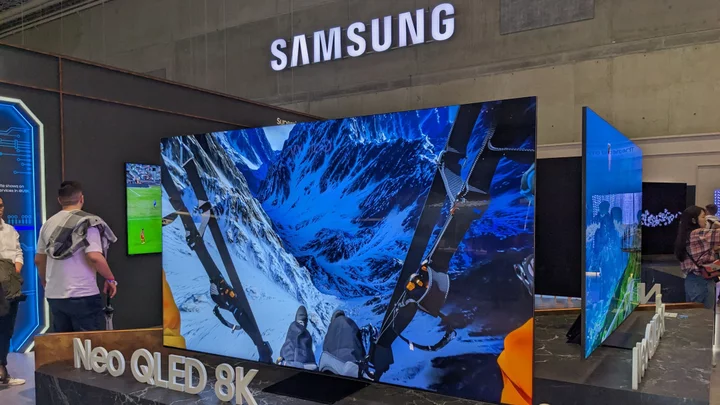BERLIN—Contrary to some industry expectations, the European Union’s energy-efficiency mandates have yet to unplug the 8K television format in the EU. But that ultra-ultra-high-definition variant continues to face other obstacles, most of which don’t stop at this side of the Atlantic.
The IFA tech trade show’s exhibits provided ample evidence of 8K’s relevancy struggles. The companies trying to make 8K a thing could talk up the size of their screens but didn’t promise anything new to watch in that resolution, while other electronics vendors with TVs on their menu either stuck to their 4K fare or switched their emphasis to efficiency and sustainability, two adjectives that 8K can’t claim today.
The EU painted a target on the power consumption of 8K sets in a regulation that went into force in March. With a resolution of 7,680-by-4,320 pixels and processors to upscale lower-resolution content, they use considerably more electricity than 4K sets and their 3,840-by-2,160 resolution.
That update to earlier “ecodesign” requirements ended an exemption on sets with above-4K resolution and instead holds 8K sets to the same “energy efficiency index” metric as 4K displays.
Dodging Regulators With 'CRT TV Levels'
In a post last October warning of this impending rule, FlatpanelsHD calculated that an 85-inch 8K set could draw more than 169 watts. The tech-news site shared this prediction with TCL Europe product development director Marek Maciejewski, who responded: "If it happens, no more 8K.”
That prediction didn’t pan out because TV manufacturers latched onto a loophole in the EU rule: While it grades TVs on the electricity they use in their default setting, it lets them offer other settings if the set warns the user about the potentially higher power draw.
"The default setting is very, very dim,” Omdia analyst Paul Gray told me on the show floor Friday.
This workaround allowed Samsung to tout a 98-inch Neo QLED 8K TV in its keynote Wednesday. Samsung Europe CMO Benjamin Braun called it "breathtaking in color, vibrance, and in size," even as other executives touted the company’s sustainability ambitions.
The 8K sets shown off at Samsung’s exhibit looked as bright and vivid as ever, suggesting that they had all been switched off any EU-compliant defaults. Fortunately, one setup at the gaming area had its remote left out, so I invited Gray to join me in playing with the settings.
(Credit: Rob Pegoraro)Navigating to an “Energy Saving Solution” and switching that on notably dimmed the screen—not as bad as a laptop in a battery-saver mode, but enough to make it look much worse than the 4K set to its right. "Oh, look at that!" Gray said, calling it "CRT TV levels."
Reversing that setting yielded a dialog warning that “Changing this setting to Off may increase power consumption.”
Even with this workaround, 8K sets rate even worse than 4K sets on the EU’s letter-grade efficiency scale. For example, all of Samsung’s 8K displays get a G rating, while “only” 72.6% of its 4K sets fall below
Samsung PR representatives did not respond to requests for comment.
Where's the 8K?
The rest of the exhibit did not surface a sequel to last year’s offer of an 8K unicorn, a TV series available in that format (season 3 of Sky’s drama Das Boot, available through the Samsung TV Plus app in the EU). That left Samsung advertising its sets’ ability to upconvert lower-resolution content to 8K, something that 8K vendors have been leaning on since 2018, plus gaming in 8K and the ability to gaze at purchased NFTs (no, really) in 8K resolution.
85-inch 8K TV next to 4K set at Samsung's IFA booth (Credit: Rob Pegoraro)The other major TV vendor to lead with 8K in its IFA exhibits, Hisense, had no better story to share about 8K content. Like Samsung, it featured 8K and 4K sets in the same sizes—with picture quality hard to distinguish on 85-inch screens from a few feet away, leaving visitors to wonder why they would want to pay potentially twice the 4K price.
Hisense did, however, point to one way out of the EU’s efficiency-regulations box: Its laser-projection TVs, which at IFA included a prototype model with a 120-inch wall-hung screen.
TCL, meanwhile, ignored 8K entirely after showing a prototype 8K display at last year’s IFA, instead sticking to 4K resolution even on displays as large as 163 inches.
And LG shunted TVs aside in an IFA exhibit centered around sustainability—an increasing focus at IFA—and filled with examples of its work in appliances and other non-video electronics.
Shrinking forecasts of 8K TV shipments in the US by the Consumer Technology Association, the Arlington, Va., trade group that runs CES, might explain this reticence by manufacturers. While in January 2021, it estimated that 1.7 million such sets would ship in 2022, as of January it had slashed that prediction to 160,000 sets, with 400,000 8K TV shipments forecast in 2023.
Omdia’s conclusion in a post last April: There’s not much more than a niche market for 8K. “8K TV is failing to appeal to consumers,” analyst Maria Rua Aguete wrote, citing research that by the end of 2026, the number of 8K-owning households will have only reached 2.7 million around the world.
“The writing's on the wall already,” said Gray at IFA. “It's a busted flush.”

